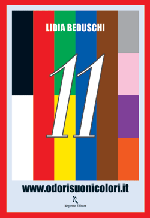Not just darkness
NOT JUST DARKNESS:
THE SENSE OF COLOR IN THE CONGENITALLY BLIND
by Daniela Floriduz *
The congenitally blind and colors: an incompatible dichotomy?
Let us begin with a fact, so obvious and self-evident that it is almost a tautology: a person who was born blind cannot have a physical perception of color. If we stick to a merely physiological and biological description, we can say that the perception of color is nothing but the ability of the eye-brain system to read a specific wavelength, later defined and classified by verbal and linguistic codes that are common knowledge to every "normally sighted" speaker. Color, therefore, is no inborn idea belonging to our DNA-transmitted genetic code; philosopher John Locke, the father of classical British empiricism, wrote in 1689 "For I imagine any one will easily grant that it would be impertinent to suppose the ideas of colours innate in a creature to whom God hath given sight, and a power to receive them by the eyes from external objects: and no less unreasonable would it be to attribute several truths to the impressions of nature, and innate characters, when we may observe in ourselves faculties fit to attain as easy and certain knowledge of them as if they were originally imprinted on the mind."
To further support these statements, I can also cite my own experience, particularly in relation to dreams. Last summer, I worked together with a researcher from the University of Bologna, recording my dreams for her each morning, as soon as I woke up, analyzing them through a questionnaire she had given me. The experiment went on for fourteen days. Amongst the onyric reminiscences grabbed from my nocturnal memories there were no chromatic elements. I am blind from birth because of a phoetal retinal malformation, and therefore I never had a visual perception of color. Yet, in one of these dreams, I remember finger-painting a cardboard piece: I could smell the sickly, sharp tang of the paint; feel its texture on my fingertips, the porosity of the colored paste on the cardboard. The dream gave me feelings of freedom, linked with childhood experiences: a group of prattling children surrounded me, the cardboard lay on the floor, and the whole circumstance was one of unrestrained play.
Of course, I cannot remember what colors I was using, perhaps because, not knowing them in real life, I cannot translate, even on an onyric level, the contents of this experience I am lacking.
Based on these considerations, it could be assumed that an exploration of the relationship between the genetically blind and colors is pointless academia. It could be said that the congenitally blind talk about colors in a merely metaphorical way, thus falling into that linguistic verbalism that typhlologists stigmatize as unactual, and misleading enough to generate a sort of cognitive autism in the vision-impaired persons. It could be argued that, even supposing to attach a truth value to this transmuted and metaphorical "experience" of color by the congenitally blind, it would add nothing to the perception of the normally sighted, to whom the meaning of color, despite being, in Locke's words, secondary (that is, the result of a modification of our senses by exposition to a given object), would maintain its universal and "objective" character, as based on experience.
In the short span of this essay, I will try to throw a different light on these apparently self-evident and unassailable statements, using personal readings and especially consideration generated by my own experience.
* Daniela Floriduz was born in 1972 in Pordenone, where she attended primary and high school. In 1996 she graduated in Philosophy at Trieste University, where she later obtained her Ph.D. in 2003.
She currently teaches History and Philosophy at high school Liceo Scientifico "Ettore Majorana" in Pordenone. She is vice-president of the local section of the Italian Union of Blind and Visually Impaired (UICI), and holds a seat in the National UICI Committee for teachers' rights.


